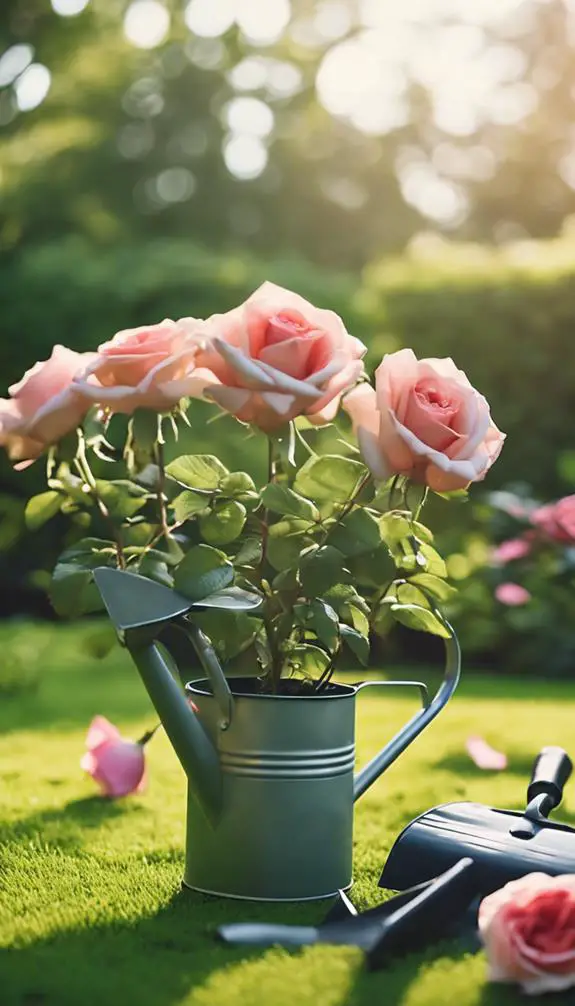As you envision a vibrant rose garden, you're likely wondering where to start. You've heard it can be challenging, but with the right guidance, you'll be enjoying those lush blooms in no time. First, you'll need to choose the perfect rose variety for your climate and garden style. But that's just the beginning – preparing the soil, providing ideal sunlight, and mastering watering techniques are all vital steps. And what about pruning, fertilizing, and protecting your roses from pests and diseases? You're about to uncover the essential tips and tricks to transform your outdoor space into a stunning rose haven.
Summary
- Select the right rose species and hybrid for your garden, considering factors like space, maintenance, and climate.
- Prepare the soil by testing its pH level, nutrient content, and structure, and take corrective action if necessary.
- Provide roses with at least six hours of direct sunlight, good air circulation, and well-draining soil to prevent disease and promote healthy growth.
- Water roses deeply but infrequently, fertilize at the right time, and prune regularly to encourage strong root growth and blooming.
- Mulch around the base of plants, remove weeds and debris, and protect roses from extreme weather to maintain a healthy and thriving garden.
Choosing the Right Rose Variety
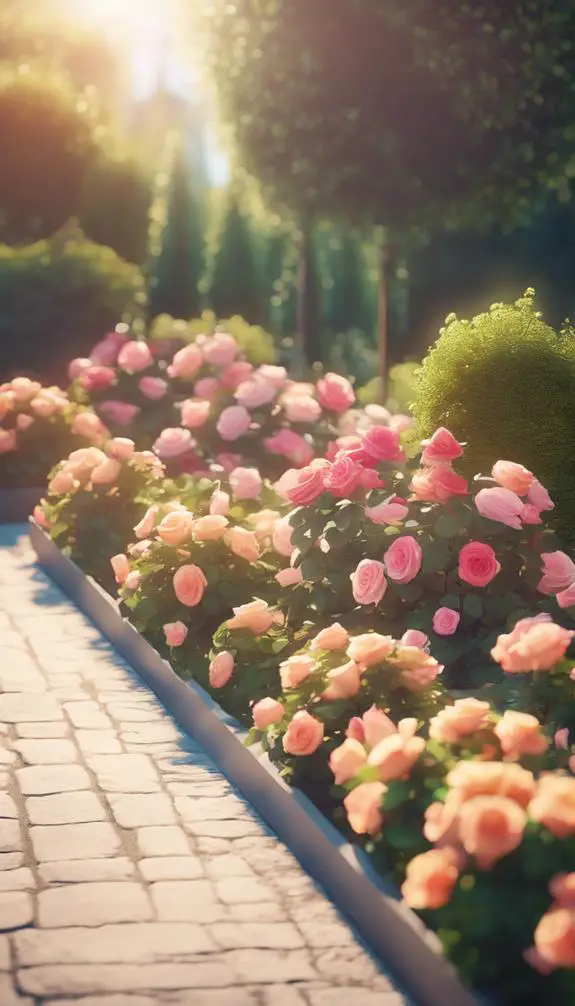
With over 150 species and thousands of hybrids, selecting the right rose variety can be a formidable task.
You'll want to ponder factors like rose colors, which range from classic red and pink to vibrant yellows, oranges, and purples.
Rose forms are another vital aspect, as they can be shrub-like, climber, or tree-like.
Ponder whether you want a compact, container-friendly rose or a sprawling, statement piece.
Think about the level of maintenance you're willing to commit to, as some varieties require more pruning and care than others.
Preparing the Soil for Planting

You'll need to assess your soil's pH level, nutrient content, and structure to create a superior environment for your roses.
This involves soil testing to determine if amendments are necessary, followed by pH balancing to certify it falls within the ideal range.
Soil Testing Essentials
Test your soil to determine its pH level and nutrient content, a pivotal step in preparing the soil for planting roses.
You'll need to understand your soil's origins, whether it's clay, silt, or sand-based, as this affects its ability to retain water and nutrients.
A soil test will also reveal the presence of beneficial microorganisms in the soil microbiome, which play a key role in decomposing organic matter and making nutrients available to your roses.
By analyzing the test results, you'll identify any nutrient deficiencies and pH imbalances, enabling you to take corrective action before planting.
This guarantees your roses receive the ideal growing conditions they need to thrive.
Soil Ph Balancing Act
Adjusting your soil's pH level is a delicate balancing act that requires precision and attention to detail, as roses are notoriously finicky about their growing conditions.
You'll need to verify your soil pH falls within the ideal range of 6.0 to 6.5, as roses struggle in soil acidity. pH fluctuations can be detrimental, so it's vital to monitor and adjust accordingly.
Test your soil regularly to identify areas that require correction. If your soil is too acidic, add lime to raise the pH; if it's too alkaline, add elemental sulfur or peat moss to lower it.
Optimal Soil Composition
Having achieved the ideal pH balance, your focus now shifts to preparing the soil composition for rose planting.
You'll want to create a superior mix that promotes healthy root growth, soil aeration, and nutrient cycling. Aim for a well-draining blend of 40% organic matter, 30% silt, and 30% sand.
Add compost or well-rotted manure to enhance nutrient availability and structure. If your soil is heavy clay or sandy, modify the ratio accordingly.
Certify the mix is loose and porous, allowing roots to breathe and absorb essential nutrients. By crafting the perfect soil composition, you'll give your roses a strong foundation for thriving growth and vibrant blooms.
Planting Roses in the Ground

You'll need to prepare the rose bed by loosening the soil to a depth of about 18 inches and adding organic matter like compost or well-rotted manure.
When choosing a location for your roses, consider the amount of sunlight the area receives, as most roses require at least six hours of direct sunlight per day.
You should also guarantee the location provides good air circulation to prevent disease and promotes healthy growth.
Rose Bed Preparation
Six to eight weeks before planting, prepare the rose bed by loosening the soil to a depth of 12 to 18 inches, as this allows the rose roots to grow deeply and establishes a strong foundation.
Remove any debris, rocks, or weeds that may interfere with root growth. If your soil is heavy clay or sandy, mix in organic matter like compost or well-rotted manure to improve its structure.
Consider incorporating a rose companion, such as marigolds or nasturtiums, into your garden layout to deter pests and enhance the overall aesthetic.
Choosing Rose Location
When selecting a location for your roses, consider the amount of sunlight the area receives, as roses require at least six hours of direct sunlight per day to thrive.
Morning sunspots, where sunlight filters through trees or buildings, can provide ideal conditions for rose growth.
You'll also want to identify rose microclimates, which are small areas with unique temperature and humidity conditions.
Avoid planting roses in areas with standing water or where water tends to collect, as this can lead to root rot.
Consider the wind direction and speed, as roses can be damaged by strong gusts.
Watering and Irrigation Tips
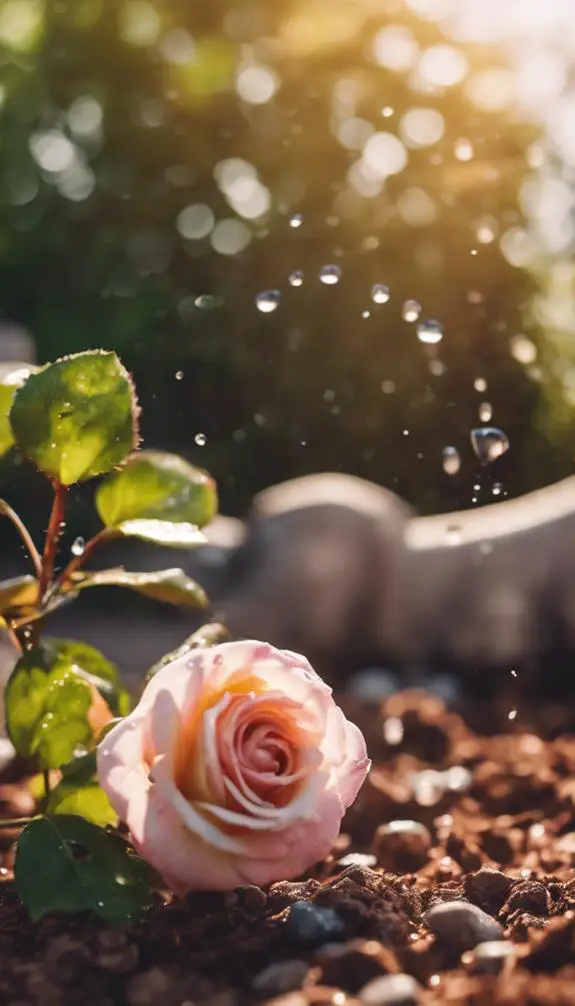
Proper watering is essential for healthy rose growth, as it directly affects the plant's ability to absorb essential nutrients.
You should water your roses deeply but infrequently to encourage deep root growth. Aim for a rose frequency of once or twice a week, depending on the climate and soil type.
Water timing is pivotal – avoid watering during the hottest part of the day to minimize evaporation and prevent fungal diseases. Instead, water in the early morning or evening when the sun isn't intense.
Mulching around the base of the plant can help retain moisture and reduce the need for frequent watering. Make sure the soil drains well to prevent waterlogged soil, which can be detrimental to your roses.
Providing Optimal Sunlight Conditions
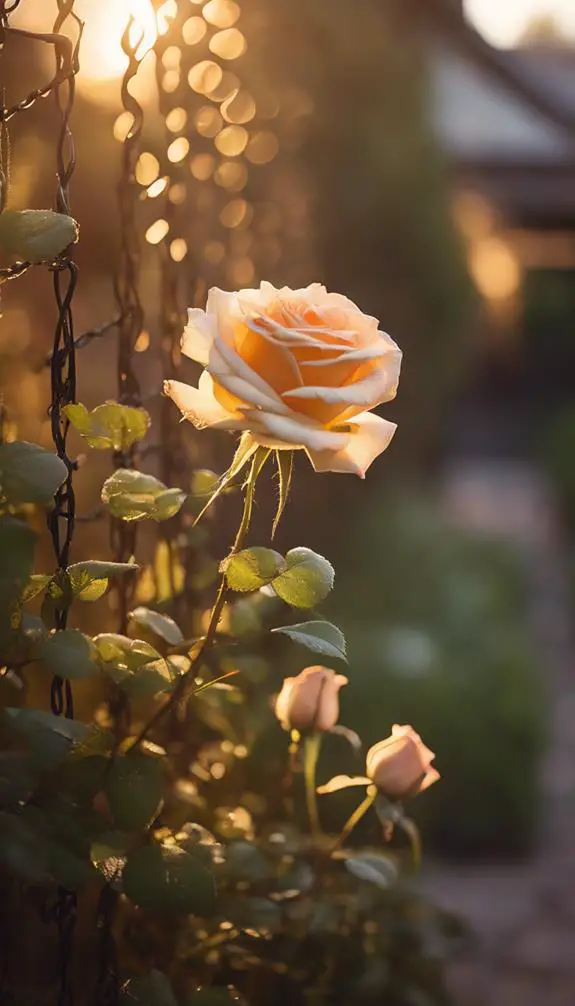
Most roses require at least six hours of direct sunlight per day to thrive, and some varieties need even more.
You'll want to position your roses in a spot that receives morning sun, as this is when the sun's rays are gentler and more beneficial. However, to prevent scorching, you should provide afternoon shade, especially in warmer climates.
South-facing gardens often receive the most direct sunlight, but you can also use trellises or arbors to train your roses to grow upwards and capture more sunlight.
Be mindful of nearby structures or trees that may cast shade, and consider pruning them to allow more sunlight to reach your roses.
Fertilizing Your Roses Regularly
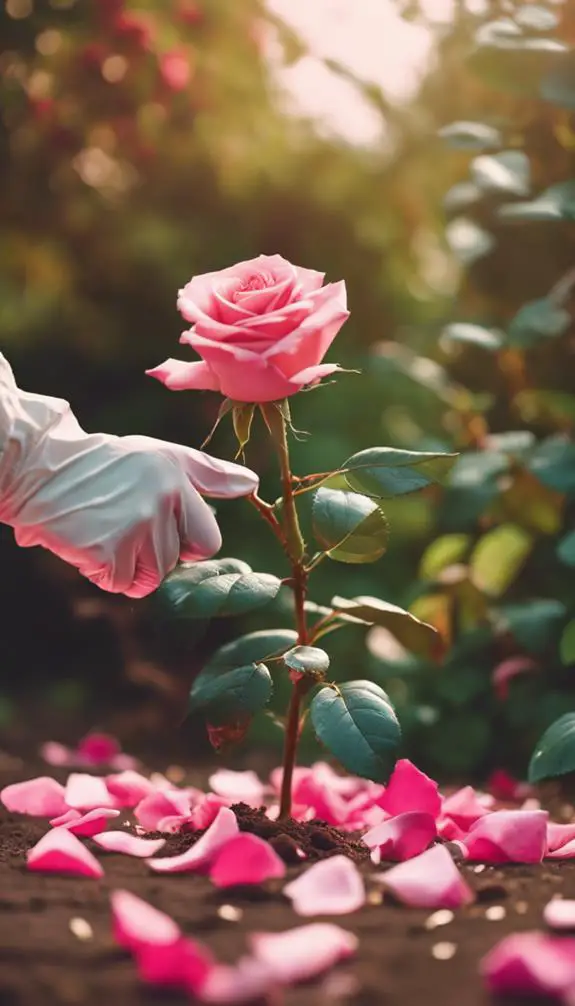
With your roses receiving the right amount of sunlight, it's now essential to provide them with a balanced diet of nutrients through regular fertilization.
You'll want to fertilize your roses at the right time to guarantee maximum growth. Fertilizer timing is critical, as it directly affects rose nutrients uptake.
Apply a rose-specific fertilizer during the growing season (spring-fall) and a balanced fertilizer during the dormant season (winter). This will promote healthy growth, blooming, and root development.
When selecting a fertilizer, look for one containing essential rose nutrients like nitrogen, phosphorus, and potassium. Additionally, consider the soil type and pH level to choose the most effective fertilizer for your roses.
Pruning Roses for Better Growth

You'll want to start pruning by cutting away dead wood, as it can harbor diseases and pests that can spread to healthy parts of the plant.
Next, prune your roses to promote air circulation, which helps prevent fungal diseases that thrive in humid environments.
Cut Dead Wood Away
Regularly, when inspecting your rose bushes, you'll notice dead, diseased, or damaged wood, which can hinder the plant's growth and promote the spread of disease.
Remove this dead wood to prevent disease from spreading and encourage healthy growth. Pruning mistakes can lead to further damage, so crucially, identify the dead wood correctly.
Look for signs like black or brown stems, cankers, or splits. Cut the dead wood at least 6 inches below the affected area, making a clean cut at a 45-degree angle.
Don't forget the importance of deadheading, as it helps redirect the plant's energy towards producing new blooms. By cutting dead wood away, you'll promote a healthier, more robust rose bush with improved growth and blooming.
Prune for Air Circulation
Proper pruning techniques play a vital role in maintaining a healthy rose bush, and one essential aspect of this is pruning for air circulation.
You'll want to remove select stems to create air pockets, allowing air to circulate freely around the plant. This helps prevent fungal diseases that thrive in humid environments.
When deciding on prune timing, consider the rose variety and its growth habits. For most types, prune in late winter or early spring, before new growth begins.
Remove stems that are crossing or rubbing against each other, as these can create areas where air can't circulate. By pruning for air circulation, you'll promote healthy growth and reduce the risk of disease in your rose bush.
Supporting Climbing Rose Varieties

A sturdy trellis or arbor provides the necessary framework for climbing rose varieties to showcase their beauty, as these roses rely on external support to grow upwards and outwards.
You'll want to choose a sturdy structure that can withstand the weight of the rose plant and its blooms. Consider installing Rose Arches or Wall Trellises, which provide a beautiful and functional way to support your climbing roses.
As you train your roses to grow up the trellis, make sure to gently tie the stems with twine or wire to secure them. This will help the rose plant grow vertically and produce more blooms.
With proper support, your climbing rose variety will thrive and become a stunning focal point in your garden.
Mulching Around Rose Bushes
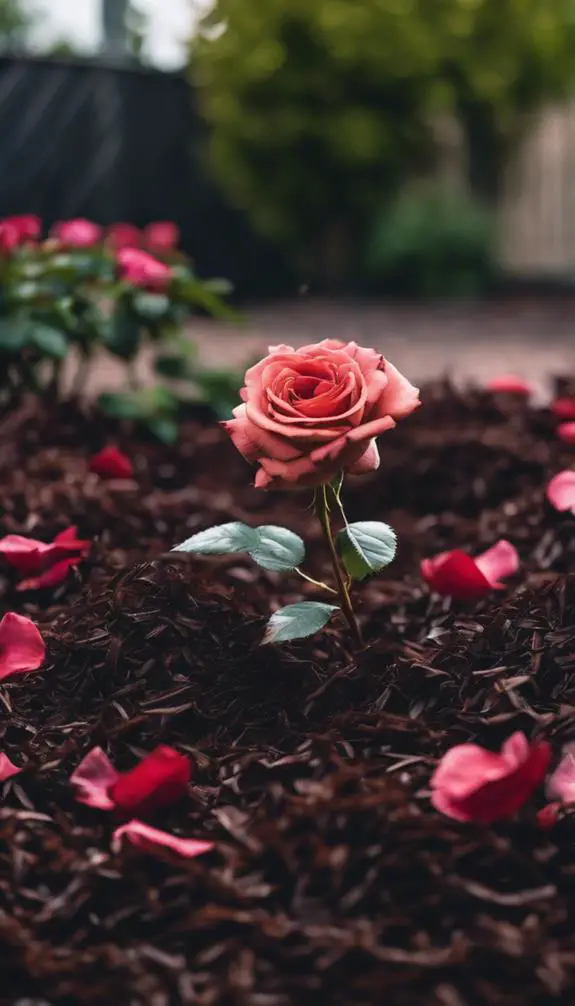
During the growing season, mulching around your rose bushes becomes essential to maintain a healthy and thriving garden.
By applying a 2-3 inch layer of rose mulch around the base of your plants, you'll conserve water, suppress weeds, and regulate soil temperature.
Choose organic mulch materials like wood chips, bark, or straw that allow for airflow and won't compact the soil.
Avoid using mulch with weed seeds, as they can germinate and compete with your roses.
Keep the mulch a few inches away from the plant stem to prevent moisture from collecting and causing rot.
Replenish the mulch as needed, and you'll enjoy a vibrant, low-maintenance rose garden.
Controlling Pests and Diseases

Vigilance is key to preventing the devastating effects of pests and diseases on your rose garden.
Regularly inspect your plants for signs of infestation or infection, such as holes in leaves, black spots, or powdery mildew.
Accurate pest identification is vital, as different pests require targeted treatments.
For instance, aphids can be controlled with neem oil, while spider mites respond to horticultural oil.
Consider using organic pesticides, like Bacillus thuringiensis (Bt) or pyrethrin, which are environmentally friendly and safe for beneficial insects.
Remember to always read labels carefully and follow instructions to avoid harming your roses.
Deadheading Roses for More Blooms
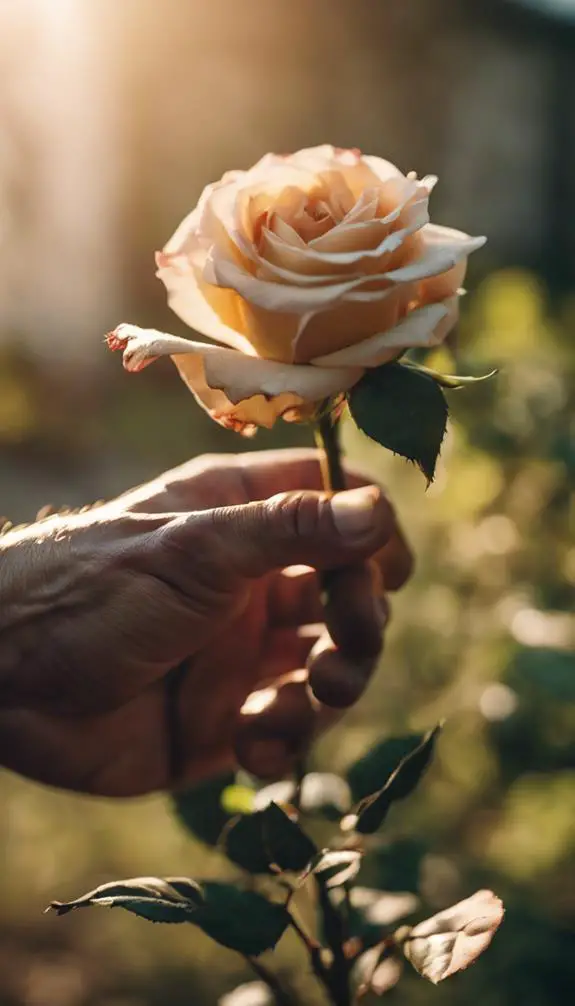
As you walk through your rose garden, you'll notice that spent blooms can make your plants look worn out and tired.
Deadheading, a vital aspect of rose maintenance, helps rejuvenate your plants and promote more blooms. Remove the faded flowers, cutting them off at the base of the stem, just above a leaf node.
This encourages the plant to redirect its energy towards producing new flowers, increasing flower longevity. Regular deadheading also helps maintain a tidy appearance, making your garden look well-manicured.
Protecting Roses From Extreme Weather

Resilience is key when it comes to growing roses, and that means preparing your plants for the unpredictable nature of extreme weather.
Keep an eye on the weather forecast to anticipate potential threats. If a storm is predicted, take action to protect your roses. Consider building storm shelters or creating a physical barrier around your plants to shield them from strong winds and debris.
You can also stake tall rose bushes to prevent them from toppling over. Additionally, mulch around the base of your plants to retain moisture and regulate soil temperature.
Maintaining Rose Garden Hygiene
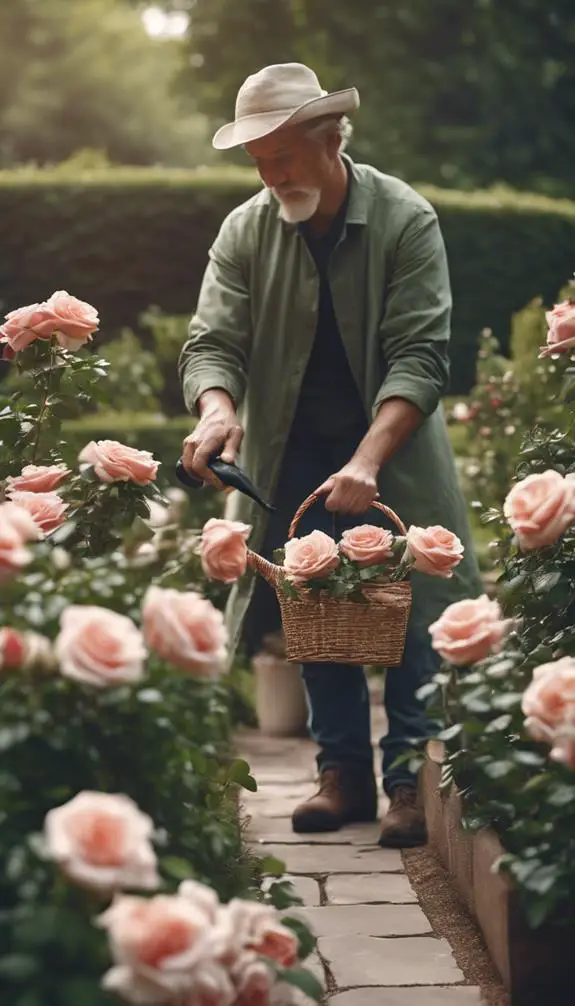
Now that your roses are protected from extreme weather, it's time to focus on maintaining a clean and healthy environment.
Regularly remove weeds, debris, and dead plant material to promote good rose sanitation and garden cleanliness.
Dispose of any infected or diseased plant material to prevent the spread of disease.
Clean your pruning tools between cuts to prevent the transmission of diseases.
Remove any fallen leaves or petals from around the base of your roses to prevent moisture buildup.
Make it a habit to inspect your roses regularly for signs of pests or disease, and take action promptly if you notice any issues.
FAQs
Can I Grow Roses in Containers if I Don't Have a Yard?
You can successfully grow roses in containers if you don't have a yard, using small spaces efficiently; choose container sizes that are at least 12-18 inches deep and 24-36 inches wide to accommodate root growth.
How Often Should I Repot My Roses to Refresh the Soil?
You'll know it's time to repot your roses when you notice soil fatigue, marked by slowed growth and decreased blooms, or when the roots become root-bound, filling the container. Repot every 2-3 years to refresh the soil and prevent these issues.
Will Deer or Rabbits Eat My Roses if I Don't Protect Them?
You'll need to safeguard your roses from deer and rabbits, which can devour them. Implement deer deterrent methods like fencing or repellents, and plant rabbit repellent plants like lavender or rosemary around your roses to keep them safe.
Can I Use Epsom Salt to Improve My Rose's Flower Production?
You can harness Epsom salt benefits to boost your rose's flower production; the magnesium in Epsom salt enhances photosynthesis, increasing blooming potential, so sprinkle 1-2 cups around the base of your roses monthly to reap the salt and roses synergy.
Are There Any Rose Varieties That Are Completely Thornless?
You'll find that some Thornless varieties, like 'Zephirine Droughin' and 'Cecile Brunner', offer thorn-free stems, while Hybrid teas, such as 'Double Delight', have minimal thorns, providing you with options for a more comfortable rose-growing experience.
Conclusion
You've successfully planted and cared for your roses, but don't forget ongoing maintenance is vital. Regularly inspect your plants for signs of pests, disease, or nutrient deficiency. Adjust your watering, fertilizing, and pruning schedule as needed. By following these guidelines and staying vigilant, you'll enjoy a thriving, blooming rose garden for years to come.


